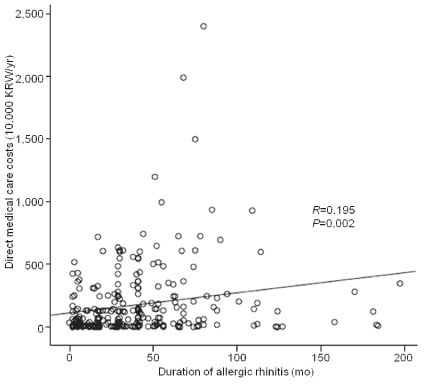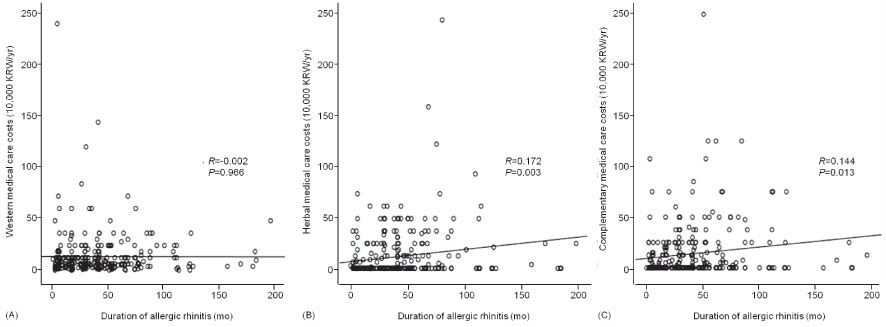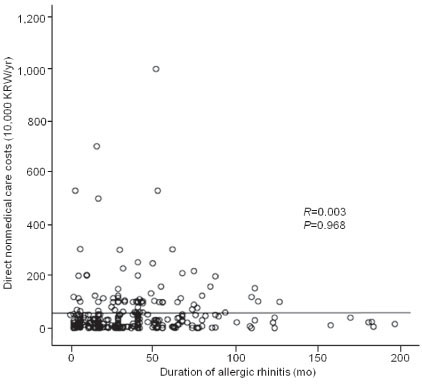Pediatr Allergy Respir Dis.
2012 Jun;22(2):138-146.
Multicenter Survey on the Economic Burden of Pediatric Allergic Rhinitis
- Affiliations
-
- 1Department of Pediatrics, Soonchunhyang University College of Medicine, Choenan, Korea. ilove902@hanmail.net
- 2Department of Pediatrics, Yonsei University College of Medicine, Seoul, Korea.
- 3Department of Pediatrics, Inje University College of Medicine, Busan, Korea.
- 4Department of Pediatrics, Konkuk University School of Medicine, Seoul, Korea.
- 5Medical Informatics & Epidemiology, Biostatistics, Soonchunhyang University, Cheonan, Korea.
- 6Atopy Clinic, Seoul Medical Center, Seoul, Korea.
- 7Department of Pediatrics, Hallym University College of Medicine, Chuncheon, Korea.
- 8Department of Health Policy and Management, Seoul National University School of Public Health, Seoul, Korea.
Abstract
- PURPOSE
The prevalence of allergic rhinitis is rapidly increasing and results in relatively high socio-economic burden on their family and community. However, studies on the economic burden of pediatric allergic rhinitis in Korea are limited. Therefore, we conducted this study to investigate the impact of pediatric allergic rhinitis on economic burden.
METHODS
Two hundred sixty two children with allergic rhinitis were enrolled in 6 secondary or tertiary medical centers in Seoul from July to September, 2008. We collected data of the economic burden of allergic rhinitis (direct medical costs, direct nonmedical costs, and indirect costs) by face to face questionnaire survey. We compared the economic burden according to the severity and the duration of allergic rhinitis.
RESULTS
The mean age of subjects was 6.54 years, and male were 174 (66.4%). Direct medical costs (10,000 Korean Won/yr) were 177.75, and direct nonmedical costs were 57.92. Although, there was no statistical significance, direct medical costs showed increasing trends in severe allergic rhinitis.(P=0.053) In addition, direct medical costs were positively correlated with duration of allergic rhinitis.(R=0.195, P=0.002). About 17% of the parents who care the allergic rhinitis children experienced the work absence due to their child's illness.
CONCLUSION
The economic burdens of allergic rhinitis were positively correlated with the severity and duration of illness. Particularly costs for alternative medicine including oriental medicine were related with severity and duration allergic rhinitis. Therefore, special efforts for education with evidence based treatment strategy are necessary to decrease the economic burden of allergic rhinitis.
Keyword
MeSH Terms
Figure
Reference
-
1. Björkstén B, Clayton T, Ellwood P, Stewart A, Strachan D. ISAAC Phase III Study Group. Worldwide time trends for symptoms of rhinitis and conjunctivitis: Phase III of the International Study of Asthma and Allergies in Childhood. Pediatr Allergy Immunol. 2008. 19:110–124.
Article2. Aït-Khaled N, Pearce N, Anderson HR, Ellwood P, Montefort S, Shah J, et al. Global map of the prevalence of symptoms of rhinoconjunctivitis in children: The International Study of Asthma and Allergies in Childhood (ISAAC) Phase Three. Allergy. 2009. 64:123–148.
Article3. Skoner DP. Allergic rhinitis: definition, epidemiology, pathophysiology, detection, and diagnosis. J Allergy Clin Immunol. 2001. 108:1 Suppl. S2–S8.
Article4. Ahn K, Kim J, Kwon HJ, Chae Y, Hahm MI, Lee KJ, et al. The prevalence of symptoms of asthma, allergic rhinoconjunctivitis, and eczema in Korean children: Nationwide cross-sectional survey using complex sampling design. J Korean Med Assoc. 2011. 54:769–778.
Article5. Jáuregui I, Mullol J, Dávila I, Ferrer M, Bartra J, del Cuvillo A, et al. Allergic rhinitis and school performance. J Investig Allergol Clin Immunol. 2009. 19:Suppl 1. 32–39.6. Woods L, Craig TJ. The importance of rhinitis on sleep, daytime somnolence, productivity and fatigue. Curr Opin Pulm Med. 2006. 12:390–396.
Article7. Kim SY, Yoon SJ, Jo MW, Kim EJ, Kim HJ, Oh IH. Economic burden of allergic rhinitis in Korea. Am J Rhinol Allergy. 2010. 24:e110–e113.
Article8. Weiss KB, Sullivan SD. The health economics of asthma and rhinitis. I. Assessing the economic impact. J Allergy Clin Immunol. 2001. 107:3–8.
Article9. Schatz M. A survey of the burden of allergic rhinitis in the USA. Allergy. 2007. 62:Suppl 85. 9–16.
Article10. Canonica GW, Bousquet J, Mullol J, Scadding GK, Virchow JC. A survey of the burden of allergic rhinitis in Europe. Allergy. 2007. 62:Suppl 85. 17–25.
Article11. Bousquet J, Fokkens W, Burney P, Durham SR, Bachert C, Akdis CA, et al. Important research questions in allergy and related diseases: nonallergic rhinitis: a GA2LEN paper. Allergy. 2008. 63:842–853.
Article12. Bousquet J, Khaltaev N, Cruz AA, Denburg J, Fokkens WJ, Togias A, et al. Allergic Rhinitis and its Impact on Asthma (ARIA) 2008 update (in collaboration with the World Health Organization, GA(2)LEN and AllerGen). Allergy. 2008. 63:Suppl 86. 8–160.13. Hong SJ, Ahn KM, Lee SY, Kim KE. The prevalences of asthma and allergic diseases in Korean children. Korean J Pediatr. 2008. 51:343–350.
Article14. Blaiss MS. Allergic rhinitis: direct and indirect costs. Allergy Asthma Proc. 2010. 31:375–380.
Article15. Soni A. Medical Expenditure Panel Survey. Allergic rhinitis: trends in use and expenditures, 2000 and 2005. 2008. Rockville: Medical Expenditure Panel Survey, Agency for Healthcare Research and Quality;(Statistical brief; No. 204).16. National Health Insurance Corporation. Chung GH, Song JS, editors. National Health Insurance Statistical Yearbook. 2007. Seoul: Korea National Health Insurance Co.;488–489.17. Lee SW, Lee KE, Park EH, Cho HS, Cha JK, Lee HR. A Survey on the use of alternative medicine in allergy patients. Pediatr Allergy Respir Dis. 2001. 11:249–259.18. Jung JH, Lee JH, Kang IG, Cha HE, Kim ST. The present state of Korean traditional medicine and alternative medicine in nasal disease. Korean J Otorhinolaryngol-Head Neck Surg. 2010. 53:12–19.
Article19. Ng TP, Wong ML, Hong CY, Koh KT, Goh LG. The use of complementary and alternative medicine by asthma patients. QJM. 2003. 96:747–754.
Article20. Lee HJ, Lee JH, Lee YW, Kim CW, Dhong HJ, Park HS, et al. Multicenter analysis of the current status of unproved complementary/alternative medicine other than herbal medication in allergy patients. Korean J Med. 2011. 80:68–77.21. Chang EY, Chung SW, Ahn KM, Lee SI. A study on the use of complementary alternative medicine in children with atopic dermatitis. Korean J Asthma Allergy Clin Immunol. 2005. 25:110–116.




